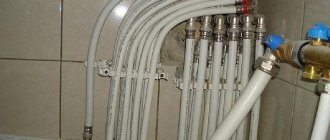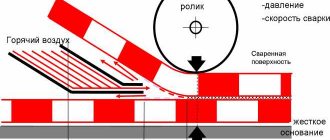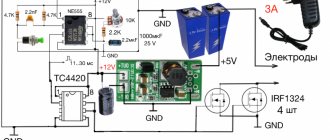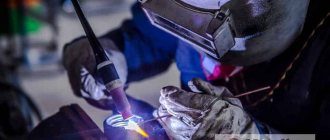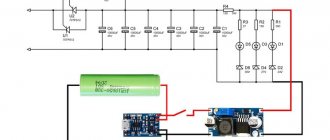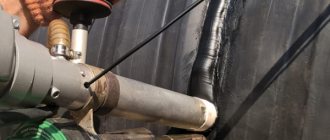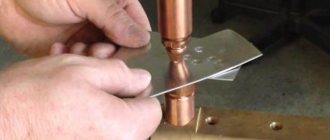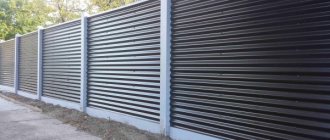Properties and types of polypropylene
Composite and monolithic slabs are created from a polymer material, obtained by rolling, which compact the porous structure, give shape, and create a smooth surface. Main characteristics of the sheet:
- high tensile strength, compression, torsion;
- low specific gravity, no more than 0.92 g/cm 3 ;
- small expansion coefficient, maintains structure homogeneity in the temperature range from +80 to -40°C;
- environmental safety, does not emit harmful components;
- chemical neutrality to aggressive environments of acidic and alkaline nature;
- hydrophobicity: the material does not absorb moisture;
- UV resistance;
- dielectricity.
The material is easy to install using fasteners and can be cut, milled, welded, or glued. The sheet is available in three types:
- dense – has a homogeneous structure;
- cellular – loose, has soundproofing properties;
- foamed - used as insulation.
Welding technology
During temperature bonding, the structure of the polymer is not disturbed; the adhesion of the parts being connected occurs due to the process of interdiffusion. Welding polypropylene sheets involves heating the joint to a viscous-flowing state. When choosing equipment, it is necessary to take into account that when heated slowly at the joints, the material shrinks, and the quality of the seam suffers as a result. The welding temperature depends on the type of tool. For installation of sheets, the polyfuse method is used, when the joints are heated. Another connection is made using an extruder. You can heat polypropylene with an air gun (hair dryer).
Having the necessary equipment, you can join the sheets with your own hands.
Methods for manual welding of polypropylene sheets
During installation, two tools are used: a welding extruder for polypropylene and a hair dryer. Polypropylene wire or welding rod is placed between the sheets to be welded. It is selected according to the type of material being installed and must correspond to it in terms of the class of material and type of manufacture.
To weld polypropylene with a hairdryer, you need a high-power tool; heating is carried out for 5–10 minutes. Before this, it is necessary to prepare the surfaces of the parts to be joined: sand them with fine sandpaper to form uneven surfaces. Then the edge is cut at an angle of 45°. For continuous laying of the rod, a nozzle is used; a welding hair dryer is usually equipped with them. It doesn’t take long to make them from tin yourself. During the process, the joint heats up to 180°C, so sheets up to 20 mm thick are mounted with a hairdryer for welding polypropylene. For sheets over 16 mm, extruder welding is applicable; this is a more reliable joining method. The tool heats the sheet up to 270°C; it is equipped with special attachments that are used when installing complex geometric shapes. They need to work quickly so that the sheet does not straighten out. If there are two nozzles on the unit, it is not recommended to turn on both at once.
The principle of operation of the extruder is to heat the rod to a homogeneous consistency, while simultaneously heating the joint and extruding the extruded polypropylene. There are models of extruders where granules can be placed instead of a rod. They are softened in a plasticizer and pressed into the working area. The result is a very high quality and durable seam.
Automatic welding
Welding machines have been created to connect sheets. This welding equipment creates a smooth, diffuse seam by touching the joint with a heating element. An automatic soldering iron is needed for large amounts of work. The temperature is regulated depending on the structure of the sheet; the machine can weld polypropylene sheets with a thickness of 16 mm or more.
Read also: Calculate the weight of a steel sheet
Methods for joining PE pipes
Polyethylene pipelines are installed in two ways: using fittings and flanges or several types of welding.
The connection requires special fittings (couplings and sockets) and without them. For pipes with a wall thickness less than 4.5 (diameters 50-110 mm), welding using fittings is used; for larger pipes with a thicker wall, butt welding and extruder welding are acceptable.
Diffusion
The diffusion method involves heating the ends to a viscous flow state. The prepared ends of the workpieces are joined and slightly compressed. Movable polymer molecules, under the influence of pressure, move into the parts being connected, mix, freeze in a new position when cooled, form new chemical bonds and ensure reliable adhesion of the pipes to each other.
It is incorrect to single out any welding method as diffusion. In fact, any welding of polyethylene is based on the process of diffusion of heated molecules.
Bell method
Not the most typical way. There are two options for implementation: using socket pipes and couplings. The method itself is reminiscent of welding polypropylene pipelines: the socket or coupling and the workpiece are heated using a soldering iron with a special nozzle. Then the workpiece is inserted into the socket of another pipe or coupling, fixed, pressed and held. Welding time – 20 seconds. If couplings are used, then the second pipe is soldered into the coupling in the same way. The cost of couplings is low; products with a socket are rarely found in stores. The connection is reliable and durable; small diameters can be welded.
Butt welding
This method is applicable to pipes with a wall thickness of more than 4.5–5 mm and a diameter of more than 50 mm.
Before carrying out work, cut off the polyethylene pipe strictly perpendicularly and thoroughly clean the ends. Then fix the pipe in the welding machine and carefully center it. A heater is inserted between the ends of the heating pipes, the pipes are pressed against it and heated until the ends soften. Then the heater is quickly removed, the ends are compressed in such a way that a small annular bead is formed at the junction - a flash. Cool the joint, then remove the machine. The work has its own subtleties; it requires two people.
Extruder welding
Extrusion - welding using a small apparatus from which molten polyethylene is extruded under pressure. Raw materials in the form of rods or granules are loaded into the extruder. Extrusion is used on pressure communications with a wall thickness of more than 6 mm, but it can also be used to patch non-pressure sewer pipelines with a thinner wall. The connection point is heated by a stream of hot air. It is advisable to chamfer the ends.
The quality of the seam is very high. The advantage of the method is that it is possible to weld an already laid polyethylene pipe without dismantling the pipeline.
Electrofusion welding
This is the most reliable, convenient and universal connection method. It can be used even in hard-to-reach places. But, unfortunately, it is also the most expensive - electric welding fittings are not cheap, and a welding machine also costs a lot. Welding with thermistor couplings is used from small to large diameter polyethylene pipelines.
During thermistor welding, polyethylene blanks are cut strictly perpendicular, carefully cleaned of burrs and dust, inserted into the coupling, and centered using special devices. The coupling has a heating element. It is connected to a special welding machine, current is supplied, the element heats up the coupling and the ends of the pipes, and they are welded.
With this type of welding, it is extremely important to keep the joint motionless until it cools completely.
Which way is better
Before choosing the best connection method, it is necessary to determine which one is applicable in a particular case, depending on the diameter of the pipeline.
Bonding polypropylene sheets
Products with uneven surfaces are bonded chemically. This method is rarely used due to the fact that polypropylene is a difficult-to-glue material, it requires a special composition, traditional mixtures for plastic are not suitable, you need to pay attention to this. There are several types of glue:
- thermoactive based on polyphenolic resins or two-component, with a hardener or hardens when heated;
- thermoplastic one-component, the curing temperature must be indicated on the packaging.
The second problem with gluing is the preliminary marking of all parts before assembly; any mistake will lead to a large loss of material, and the work will have to start again. Marks are made on the ends of the parts to be joined so that the surface remains clean.
Let's sum it up
Typical welding mistakes that beginners make:
- Wet and dirty joints reduce the quality of the connection; they can get dirty when laid on a flat surface, so this is also cleaned.
- Wrong choice of filler rod; it is important to know the markings of the sheet before purchasing it. Letter symbols indicate the type of polymer: BS (block layer), V (foamed), G (homogenized), M (monolithic), PP (polymer).
- Uneven heating of the working area and the additive; if the rod is soft, it will be difficult to press it between the elements being welded, it will bulge, and it will be easy to pull it out. If the additive is colder than the sheet, wrinkles will form at the seam.
- Low or high speed of adding the additive: at low speed, deposits will form, at high speed, the seam will tighten.
- To check the strength of the connection, the cooled seam is heated with hot air, then all defects become noticeable.
Main characteristics of polypropylene
This material is produced industrially from macromolecules of an isotactic structure, and the process of formation of polypropylene in the form of sheets is as follows: the molten material is passed through rollers. Polypropylene is characterized by its use in the creation of various containers, large-diameter pipes, it also has insulating properties and in this area it has also found active use.
Let us note the main characteristics characteristic of sheet polypropylene:
- Does well in humid environments
- Differs in mechanical strength,
- The material is resistant to various chemicals: alkalis, acids, salt solutions.
- Not afraid of ultraviolet rays.
Another important feature characteristic of polypropylene is the versatility of its installation. This material can be cut and joined in many ways. Currently, the most commonly used are the following:
- Mechanical. It involves the use of fasteners. It is worth noting that a structure made in this way will not have high thermal insulation properties.
- Gluing. This method is very popular because the material is in good contact with mechanical substances, and the glue will not damage it in any way.
- Welding polypropylene sheets. Using this method, you will get a high-quality and durable connection; a special tool for welding polypropylene will help with this.
Technologies for welding polypropylene
- extruder welding,
- welding polypropylene sheets with a hair dryer,
- connection using a polyfusion method (similar to resistance welding).
Let's take a closer look at each of the technologies.
The first type of welding is based on the use of a special apparatus - a manual extruder to connect parts. The device is small in size and comes with different sized attachments.
It is well suited for connecting three-dimensional parts that have a fairly complex structure. For example, welding of membrane roofing is very often carried out using this machine. It is also successfully used as a machine for welding PVC pipes.
Most often, the extruder used for welding polypropylene is equipped with a mechanism responsible for supplying air, through which the plastic in the welding area heats up and becomes softer.
The technology for welding polypropylene using the extrusion method must be carried out with a mandatory condition: in the weld area it is necessary to use an additive substance, which is usually polypropylene wire. Hot air heats the surfaces of parts being welded to a viscous state. The additive that passes through the extruder also becomes hot and is mixed with the base until a homogeneous substance is obtained. This method allows you to connect very thick parts, for example welding a membrane roof, as well as materials whose thickness is small. Therefore, welding of polyethylene sheets is also very often carried out using this technology.
Read also: Precision investment casting
roof welding with extruder
The next method is welding polypropylene sheets with a hairdryer. An important and integral component of this technology is the flow of heated air (170°C-180°C).
construction hair dryer
This method has found its application in fastening parts whose material thickness does not exceed 20 mm. Such indicators are typical for polyethylene sheets. In this regard, it becomes clear that the seam that is ultimately formed will not be very strong. Therefore, welding polypropylene sheets using a hair dryer can only be used if the parts being joined are small in size and will not be subject to heavy loads in subsequent use.
The main equipment for polyfusion welding of polypropylene is special welding moving tables. Two sheets are placed on the machine, then they are well fixed with a special clamping device. The person performing the work must set the thickness and length of the elements that will be welded. Next, the ends of the sheets are pressed tightly against the heating element; when the desired temperature is reached, this heating element leaves the welding zone, and sliding tables press the parts. The result is a very reliable and high-quality seam, which, in terms of its technical and operational characteristics, is the best obtained by other methods.
Polypropylene sheet welding technology
Today, such material as polypropylene has become widespread in the construction industry. Sheet polypropylene is characterized by the following properties: efficiency, reasonable price, easy installation. Welding of polypropylene sheets is considered one of the most commonly used technologies for processing this material. In this article we will talk in detail about this process.
Main characteristics of polypropylene
This material is produced industrially from macromolecules of an isotactic structure, and the process of formation of polypropylene in the form of sheets is as follows: the molten material is passed through rollers. Polypropylene is characterized by its use in the creation of various containers, large-diameter pipes, it also has insulating properties and in this area it has also found active use.
Let us note the main characteristics characteristic of sheet polypropylene:
- Does well in humid environments
- Differs in mechanical strength,
- The material is resistant to various chemicals: alkalis, acids, salt solutions.
- Not afraid of ultraviolet rays.
Another important feature characteristic of polypropylene is the versatility of its installation. This material can be cut and joined in many ways. Currently, the most commonly used are the following:
- Mechanical. It involves the use of fasteners. It is worth noting that a structure made in this way will not have high thermal insulation properties.
- Gluing. This method is very popular because the material is in good contact with mechanical substances, and the glue will not damage it in any way.
- Welding polypropylene sheets. Using this method, you will get a high-quality and durable connection; a special tool for welding polypropylene will help with this.
Technologies for welding polypropylene
- extruder welding,
- welding polypropylene sheets with a hair dryer,
- connection using a polyfusion method (similar to resistance welding).
Let's take a closer look at each of the technologies.
The first type of welding is based on the use of a special apparatus - a manual extruder to connect parts. The device is small in size and comes with different sized attachments.
It is well suited for connecting three-dimensional parts that have a fairly complex structure. For example, welding of membrane roofing is very often carried out using this machine. It is also successfully used as a machine for welding PVC pipes.
Most often, the extruder used for welding polypropylene is equipped with a mechanism responsible for supplying air, through which the plastic in the welding area heats up and becomes softer.
The technology for welding polypropylene using the extrusion method must be carried out with a mandatory condition: in the weld area it is necessary to use an additive substance, which is usually polypropylene wire. Hot air heats the surfaces of parts being welded to a viscous state.
The additive that passes through the extruder also becomes hot and is mixed with the base until a homogeneous substance is obtained. This method allows you to connect very thick parts, for example welding a membrane roof, as well as materials whose thickness is small.
Therefore, welding of polyethylene sheets is also very often carried out using this technology.
roof welding with extruder
The next method is welding polypropylene sheets with a hairdryer. An important and integral component of this technology is the flow of heated air (170°C-180°C).
construction hair dryer
This method has found its application in fastening parts whose material thickness does not exceed 20 mm. Such indicators are typical for polyethylene sheets. In this regard, it becomes clear that the seam that is ultimately formed will not be very strong. Therefore, welding polypropylene sheets using a hair dryer can only be used if the parts being joined are small in size and will not be subject to heavy loads in subsequent use.
The main equipment for polyfusion welding of polypropylene is special welding moving tables. Two sheets are placed on the machine, then they are well fixed with a special clamping device. The person performing the work must set the thickness and length of the elements that will be welded.
Next, the ends of the sheets are pressed tightly against the heating element; when the desired temperature is reached, this heating element leaves the welding zone, and sliding tables press the parts.
The result is a very reliable and high-quality seam, which, in terms of its technical and operational characteristics, is the best obtained by other methods.
conclusions
In this way, you can connect not only polypropylene sheets, but also PVC films, HDPE sheets, and parts made of sheet plastic.
You should choose a welding machine based on what material you are joining and what the welded elements will be used for. You can do the welding yourself and choose: a hair dryer, an extruder, and also weld using the polyfusion method.
[Total: 3 Average: 1.7/5]
Source: https://svarkaed.ru/svarka-plastmass-i-polimerov/obshhee/tehnologiya-svarki-listovogo-polipropilena.html
conclusions
In this way, you can connect not only polypropylene sheets, but also PVC films, HDPE sheets, and parts made of sheet plastic.
You should choose a welding machine based on what material you are joining and what the welded elements will be used for. You can do the welding yourself and choose: a hair dryer, an extruder, and also weld using the polyfusion method.
One of the most common methods of joining polypropylene is welding. This technology is the most popular and effective, this is explained by the thermoplasticity and strength of the materials. Welding of polypropylene sheets occurs due to their joining end-to-end or at right angles. You can also use an extruder, hair dryer or butt welding machine for joining.
Polypropylene sheet: nature of the material for the workpiece
This material is produced by squeezing polymer granules out of special holes. This technology allows you to end up with a sheet of any length and width. The leaf itself consists entirely of granules. The coating of such material can be either glossy or matte; if the sheet is coated with gloss, then it is covered with a film on top.
The main advantages of polypropylene are:
- dielectricity;
- sufficient hydrophobicity;
- resistance to abrasion;
- chemical strength.
Due to its special characteristics, welding polypropylene sheets is not a very voluminous process and is accessible. The entire welding process consists of bringing the edges of the material to a viscous state and pressing firmly against each other. Such a mechanism will help to obtain a solid part in the future.
Diffusion welding
Before starting work, it is necessary to prepare the workplace and all the material. To ensure that the gluing seams are as smooth and unnoticeable as possible, you should approach the process with complete seriousness and choose the welding method that will be most accessible and convenient for you. One of the most effective ways to join polypropylene sheets is diffuse welding. Such a mechanism is connected on a specially equipped welding machine.
Welding of polypropylene sheets occurs by placing two parts on the machine and fixing them. The ends of the sheets will be pressed against the heating element. To obtain the best effect, the sheets should be heated for a long time. After reaching the required temperature, the sheets are pressed using a locking mechanism. The seam obtained using welding equipment will be the strongest and most reliable.
Read also: How to check an electric motor for serviceability with a tester
Very important for such welding is cleanliness and low humidity in the room; the air temperature should be warm. One of the main advantages of the seam will be not only its strength, but also the speed of obtaining high-quality material. This method is suitable for sheets of any width, and makes it possible to weld polypropylene sheets into rolls. When there is a lot of work, a welding machine will become an indispensable thing.
Do-it-yourself welding of HDPE sheets
May 8, 2018
We understand the types and possibilities of welding sheet plastics and more.
Welding plastics is the most convenient and least expensive way to connect plastic elements. In some cases, there are no alternatives at all (when joining with glue is impossible).
In addition, hot welding of plastics is carried out en masse, both by specialists in industrial organizations and by ordinary people, as needed.
Of course, with all the accompanying tools, taking into account the development of the industry and the spread of branded accessories, there are no problems.
There are a huge number of ways to weld polymers. Most of them can be immediately divided into a couple of conditional groups: welding with the help of heat and without the help of hot air apparatus. The most actively used method is heating the material to a viscous flow state. But even in this case, several types of heating and devices are used:
- Heated gas
- Molten additive
- Heated tool
- Light or laser radiation
- Ultrasound
- High frequency current
All polymers are also further divided into thermoplastics and thermosets.
Thermoplastics are excellent for welding, since they do not change their composition during the heating process, and after cooling they also regain all their physical properties.
Thermoset plastics, on the contrary, take on their properties only once during manufacture and cannot be subjected to further heating, after which their structure is not restored.
When interacting with a heating element, the structure of the thermoplastic becomes soft and pliable, and two separate thermoplastic objects are mixed into one. This creates unbreakable seams of high strength.
How to weld polypropylene sheets and pipes made from it - Welding Profi
One of the most common methods of joining polypropylene is welding. This technology is the most popular and effective, this is explained by the thermoplasticity and strength of the materials. Welding of polypropylene sheets occurs due to their joining end-to-end or at right angles. You can also use an extruder, hair dryer or butt welding machine for joining.
Polypropylene sheet: nature of the material for the workpiece
This material is produced by squeezing polymer granules out of special holes. This technology allows you to end up with a sheet of any length and width. The leaf itself consists entirely of granules. The coating of such material can be either glossy or matte; if the sheet is coated with gloss, then it is covered with a film on top.
The main advantages of polypropylene are:
- dielectricity;
- sufficient hydrophobicity;
- resistance to abrasion;
- chemical strength.
Due to its special characteristics, welding polypropylene sheets is not a very voluminous process and is accessible. The entire welding process consists of bringing the edges of the material to a viscous state and pressing firmly against each other. Such a mechanism will help to obtain a solid part in the future.
Diffusion welding
Before starting work, it is necessary to prepare the workplace and all the material.
To ensure that the gluing seams are as smooth and unnoticeable as possible, you should approach the process with complete seriousness and choose the welding method that will be most accessible and convenient for you.
One of the most effective ways to join polypropylene sheets is diffuse welding. Such a mechanism is connected on a specially equipped welding machine.
Welding of polypropylene sheets occurs by placing two parts on the machine and fixing them. The ends of the sheets will be pressed against the heating element.
To obtain the best effect, the sheets should be heated for a long time. After reaching the required temperature, the sheets are pressed using a locking mechanism.
The seam obtained using welding equipment will be the strongest and most reliable.
We recommend! Aluminum welding technology with step-by-step instructions
Welding using an extruder
This method requires the presence of a special tool - an extruder. This machine is equipped with various attachments that allow you to weld the most complex and bulky structures. The small size of the equipment is also a huge advantage. The extruder is equipped with automatic supply of warm air, which allows you to soften the sheets and avoid any damage during welding. Working with this method requires efficiency in action, since due to the high temperature (about 270C), deformation is possible near the inner layers of polypropylene.
This process does not require a separate room and connection is possible directly at the workplace, due to the compactness of the device. The seam obtained using an extruder is the second strongest after a welding machine. The disadvantage of this method is the need to connect polypropylene of the same composition and class, otherwise the seams will be weak and uneven.
How to weld polypropylene sheets and pipes made from it - Welding Pro
One of the most common methods of joining polypropylene is welding. This technology is the most popular and effective, this is explained by the thermoplasticity and strength of the materials. Welding of polypropylene sheets occurs due to their joining end-to-end or at right angles. You can also use an extruder, hair dryer or butt welding machine for joining.
Welding using an extruder
This method requires the presence of a special tool - an extruder. This machine is equipped with various attachments that allow you to weld the most complex and bulky structures. The small size of the equipment is also a huge advantage.
The extruder is equipped with automatic supply of warm air, which allows you to soften the sheets and avoid any damage during welding.
Working with this method requires efficiency in action, since due to the high temperature (about 270C), deformation is possible near the inner layers of polypropylene.
This process does not require a separate room and connection is possible directly at the workplace, due to the compactness of the device.
The seam obtained using an extruder is the second strongest after a welding machine.
The disadvantage of this method is the need to connect polypropylene of the same composition and class, otherwise the seams will be weak and uneven.
Welding polypropylene sheets with a construction hair dryer
To weld polyethylene sheets with a hair dryer, you will need a high-power construction hair dryer and thin
polymer sheets, as well as polypropylene wire (selected to match the size and thickness of the sheets that need to be connected).
An important factor is the selection of material; sheets and wire must consist of the same class of materials.
Neglecting this point will significantly affect the quality of the resulting seam and its strength, since the hair dryer will not be able to simultaneously bring different types of materials to the same required temperature.
For normal joining of sheets, they must be placed on a flat surface and the edges must be sanded. An important point in preparation is cutting the edges at an angle of 45.
Prepared polypropylene sheets for butt welding
The process of heating the hairdryer and melting the rod takes approximately 5 to 10 minutes. Next comes the welding process itself. A plastic rod is inserted into the nozzle of a welding gun and, while filling the seam, is continuously fed into the weld zone.
After following all procedures, the combined material can be used. The resulting seam when welding HDPE using a heat gun is less strong than when welding with a machine or extruder, however, this method will be ideal for joining material with a small thickness.
Bonding polypropylene sheets
Gluing polypropylene is a very labor-intensive process that requires special training. This is due to the fact that this type of plastic is especially difficult to glue.
There are a large variety of adhesives on the modern market that can glue plastic together without any problems; the main issue will be the choice of a special solution.
Special preparation for gluing the material will consist of pre-assembling all the parts in order to put the necessary marks, because incorrect connection of polypropylene sheets or a simple mistake in the process can cost you damaged material.
The main recommendations for gluing and welding polypropylene with your own hands are:
- It is necessary to purchase glue, paying attention, first of all, to its brand, but not to the price. Your experience in this matter will be an additional bonus for you. Sometimes glue from a high price category may be inferior in quality to cheaper analogues;
- It will be very important to pay attention to sharpening and processing the edges of polypropylene sheets; if this requirement is fulfilled correctly, the seam will turn out very neat;
- choose the welding method depending on the width of the sheet, as well as its size. The more correctly the joining technique is chosen, the stronger the resulting seam will be.
Welding polypropylene sheets - choosing a welding machine for welding polymer
Polypropylene sheets are currently widely used in the production of containers for enterprises in the electronics, chemical, petrochemical, radio engineering, food, metallurgical and other industries. This material is also used in the manufacture of swimming pools.
Polypropylene is often compared to the “king” of plastics. It is not the most popular and in demand polymer at this time, but in terms of production growth rates it is the undisputed leader.
Main technical indicators of polypropylene
Polypropylene, as a synthetically non-polar thermoplastic material, is produced industrially from macromolecules with an isotactic structure. At room temperature the material is insoluble in organic liquids, but it can dissolve in some types of solvents when heated to high temperatures.
Polypropylene is resistant to alkalis, acids, salt solutions and other inorganic aggressive environments, has a low level of moisture absorption, high electrical insulating properties, good mechanical properties, increased rigidity and a high level of impact resistance.
Technology and general principles of polypropylene welding
Welding polypropylene sheets involves joining parts by heating the material without changing its chemical composition. The polymer binds together to create a viscous-fluid state when heated.
Do-it-yourself polypropylene welding can be done using a special gun with hot air supply (hair dryer). In the design of such a device, the air is heated evenly, which creates a good environment for welding polymer parts.
An extruder, as a device for welding polypropylene, is also often used in production. This process is carried out in a dry, warm room. The joint surfaces (edges) of the parts to be welded must be cleaned with fine sandpaper.
A mechanical welding machine for polypropylene is used mainly in cases where it is necessary to exert maximum effort so that the edges of the parts come into contact with each other. It is not always possible to achieve this with the help of improvised means.
Welding polypropylene (the video is on the website) mechanically involves the use of a special support frame with an instrument block and a hydraulic unit. This frame has special grips on both sides, between which liners are installed to maintain optimal pressure distribution on the elements being connected.
A welding machine for polypropylene has a heating element, which is a disk with a special coating. Inside this disk there are heating components (heating elements), and outside there are temperature control sensors and thermostats.
The more accurate the readings of the temperature sensor, which is built into the machine for welding polypropylene, the better the quality of the machine itself. The highest quality units are considered to be those with electronic thermostats (thermistors that are capable of measuring temperature close to the couplings and mandrels).
Welding polypropylene sheets in some cases also involves the use of various auxiliary materials (calibrator, chamfer, scissors, trimmer, cleaning fluid, etc.).
Safety requirements for welding polypropylene
During the welding process of polymer products, several rules must be followed:
- operating temperature – not lower than 5°C;
- welding of polypropylene sheets can be carried out not only indoors, but also outdoors;
- at low temperatures (below 5°C) the technological pause may be too close to zero;
- Before performing welding work, it is mandatory to clean the welding nozzles to avoid the ignition of plastic residues and the release of carbon dioxide;
- if the room where welding is carried out is poorly ventilated, the release and accumulation of harmful gases is possible;
- For welding work with polypropylene, it is recommended to have special protective gloves and goggles (face protection mask).
For a more detailed introduction to the process of joining two polymer sheet products, it is recommended to watch the polypropylene welding video.
How to properly weld polypropylene pipes with your own hands
Polypropylene pipes, which appeared at the end of the last century, are now very popular on the market and are gradually replacing classic metal pipes. Such widespread use of such pipelines is explained by the excellent performance characteristics of such material. Let's tell you in more detail about how to weld polypropylene pipes with your own hands.
The popularity of polypropylene is explained by the excellent characteristics of this material. If we talk about their advantages, we can note the following:
- a light weight;
- complete resistance to corrosion;
- excellent durability;
- wear resistance;
- affordable price;
- ease of operation.
It is not surprising that, given such numerous advantages, polypropylene pipes have become widespread on the market and are used not only by private homeowners, but also in industrial construction, and housing and communal services for laying communications.
Welding polypropylene pipes
The high reliability of such seams allows for hidden installation of the pipeline with the pipes being embedded in the building structure. The most popular technology today is permanent connection by welding using appropriate fittings.
Welding polypropylene sheets with a construction hair dryer
To weld polyethylene sheets with a hair dryer, you will need a high-power construction hair dryer and thin polymer sheets, as well as polypropylene wire (selected for the size and thickness of the sheets that need to be joined). An important factor is the selection of material; sheets and wire must consist of the same class of materials. Neglecting this point will significantly affect the quality of the resulting seam and its strength, since the hair dryer will not be able to simultaneously bring different types of materials to the same required temperature.
For normal joining of sheets, they must be placed on a flat surface and the edges must be sanded. An important point in preparation is cutting the edges at an angle of 45.
The process of heating the hairdryer and melting the rod takes approximately 5 to 10 minutes. Next comes the welding process itself. A plastic rod is inserted into the nozzle of a welding gun and, while filling the seam, is continuously fed into the weld zone.
After following all procedures, the combined material can be used. The resulting seam when welding HDPE using a heat gun is less strong than when welding with a machine or extruder, however, this method will be ideal for joining material with a small thickness.
Welding polyethylene using instruments
- November 24
- 47 rating
Welding of polyethylene can be performed both in ordinary and industrial conditions. Its implementation is most popular when creating coverings for greenhouses, where pieces of material are joined using contact heating. Soldering may also be needed for book covers, packaging bags, and other needs.
Film welding scheme.
Welding of polyethylene film is carried out by bringing the polymer material into a viscous state. To do this, its edges are heated to a temperature at which melting begins, then they must be connected and squeezed tightly. To do this correctly, you can use a device specially designed for this purpose for welding polyethylene. The operation of such devices can be carried out in several modes, which are set depending on the thickness and characteristics of the polymer and its type.
Types of polyethylene compounds
The simplest and least expensive method for joining polymer materials is the so-called contact welding of polyethylene. In this way, reliable connections are formed that are preserved during subsequent operation.
Ultrasonic welding diagram.
To perform resistance welding, the joined edges of the polymers are heated with "hot air" or a "hot wedge" until they melt. Compression and seam formation are carried out by roller elements specially designed for clamping. The resulting seam will be single or double; it has good strength.
A method called “hot air” is a heated air stream that softens and melts the polymer. For the same purpose, a heating part made of metal is used - a “hot wedge”. Contact between the elements and the polymer is carried out both from the outside and from the inside, and good strong seams are formed.
In addition to the contact connection method, extrusion welding can also be used. When choosing this method, the molten polymer is supplied under pressure, the surfaces connected to each other change their state from dense to viscous, and squeezing helps to fasten them together.
Return to contents
In production conditions, it is possible to weld pieces of polymer using a special apparatus. It is used to work with such types of materials as HDPE, PVC, polypropylene and others like them.
Iron attachment diagram.
This device has the following operating principle: the wheels are driven from the engine through a gearbox, and a “hot wedge” is placed along the tripod between arranged sheets of material. The thermostat of the device puts into operation a system that automatically maintains the desired temperature. This helps ensure greater accuracy and reduces the likelihood of large temperature fluctuations. The operating speed is controlled automatically, and a relatively stable voltage is ensured in the electrical circuit.
Such equipment meets safety standards and provides greater ease of use. Welding is carried out at a certain speed, which can be adjusted manually. The required pressure is transmitted through the pressure rollers using a special lever.
The device allows you to obtain a double seam on dense material, the strength of which is approximately 85%. The process is carried out automatically; you only need to manually adjust the temperature and speed of the working element.
The “hot air” device can be described as a type of industrial hair dryer. Its advantage is its lightness. The device is suitable for long-term use. The mechanism is very powerful, and therefore the effect is quite effective. Its use is possible for such types of material as HDPE, PVC, LDPE film.
Return to contents
Diagram of a hot wedge welding machine.
Manual welding of polymers cannot be done without the appropriate equipment and tools, which in most cases can be made independently from outdated household appliances.
Even a regular electric iron equipped with a temperature regulator will do the simplest thing. A soldering iron powered by electricity would also be useful.
Using an iron, the edges of the PVC film are joined as follows. A block made of wood and properly planed is placed on the table. The edges of the polymer intended for welding are placed on it - they should protrude beyond the lining material by approximately 2 cm.
Lay sheet material on top of the film that is difficult to melt: it can be fluoroplastic, paper, newspaper. Be careful not to char the paper while working.
To speed up the joining of the edges of the parts, after heating the material, you must immediately cool this section of the film - prepare in advance a piece of wet cloth, which, after heating, you need to blot the soldered polymer.
The iron thermostat should be set to 120-150°C. The temperature of the device, powered by electricity, is the main technological indicator that serves for the correct connection of polyethylene.
If you have never welded polyethylene in the manner described before, it is better to practice a little first. Place the sheets of film intended for welding overlapping on a flat surface, for example, on a table top, cover the top with a sheet of newspaper or any paper. Heat the iron, tilt it slightly and move it over the place where the seam should be. If the connection is of poor quality or even does not form, check the temperature indicator.
Few people manage to get a reliable and beautiful seam the first time - be patient, and gradually everything will work out.
Return to contents
Welding of polyethylene sheets can be carried out using special attachments that are mounted on an electric iron. This accessory part is made of sheet aluminum. The base of the nozzle is flat, at the bottom there are relief elements - ribs, which are directly involved in the process.
Scheme for welding polyethylene film using an electric iron: 1 – table (stand), 2 – rail, 3, 4 – film panels, 5 – lining, 6 – iron.
The use of the part contributes to the formation of two reliably soldered strips located in parallel on the material.
The nozzle is very easily fixed on the soleplate of the iron: for this purpose it has special petals that must be folded under the base of the device.
To operate, it is better to set the thermostat of the device to the mark intended for working with linen fabrics.
To determine that the nozzle has heated up to the desired state, you can apply a wet cloth to it. If you hear the hissing sound of liquid evaporating, it's time to get to work.
The “ribs” of the nozzle are installed at the junction of the edges of the film on top of the laid paper, then the device is slowly moved over the place intended for connection. It turns out to be a double seam.
Return to contents
An ordinary electric soldering iron is also suitable for bonding film at home. It is best to put a tip with a student or poster pen made of metal on its sting. If the polymer is burned through, the tip is slightly moved from the tip of the device - this reduces the heat transfer area.
Soldering is more reliable if you attach special rollers to the soldering iron. The tip is ground off until it stops, a groove is cut in the center of the end, for which a hacksaw is used. You will need a copper disk with a diameter of 1 cm (those who are serious about building such a device can grind it themselves).
Drill a hole with a diameter of approximately 5 mm to attach the axle, insert the disc into the slot made and secure it. It should rotate freely. To ensure an even weld, guide it along a ruler. The device must be guided to the point where the seam ends, without tearing it off, with pressure. This approach is most often used for sealing bags. To get a beautiful seam, practice a little on unnecessary pieces.
expertsvarki.ru
Bonding polypropylene sheets
Gluing polypropylene is a very labor-intensive process that requires special training. This is due to the fact that this type of plastic is especially difficult to glue. There are a large variety of adhesives on the modern market that can glue plastic together without any problems; the main issue will be the choice of a special solution. Special preparation for gluing the material will consist of pre-assembling all the parts in order to put the necessary marks, because incorrect connection of polypropylene sheets or a simple mistake in the process can cost you damaged material.
The main recommendations for gluing and welding polypropylene with your own hands are:
- It is necessary to purchase glue, paying attention, first of all, to its brand, but not to the price. Your experience in this matter will be an additional bonus for you. Sometimes glue from a high price category may be inferior in quality to cheaper analogues;
- It will be very important to pay attention to sharpening and processing the edges of polypropylene sheets; if this requirement is fulfilled correctly, the seam will turn out very neat;
- choose the welding method depending on the width of the sheet, as well as its size. The more correctly the joining technique is chosen, the stronger the resulting seam will be.
Methods for welding polypropylene pipes
To connect polypropylene pipes, several welding methods are used depending on their diameter, wall thickness and area of application:
- Stykova. The technique is used for joining large-diameter pipeline elements used in industrial and public utilities. The process occurs by simultaneous heating of pipe ends pre-cut at an angle of 90 degrees with a flat disk, after which their edges are forcefully pressed against each other on a special machine.
- Coupling. The technology is practically not used in welding polypropylene pipes (mainly with HDPE); the connection occurs using electric welded couplings, into which both ends of the pipe elements are inserted. When an electric current is passed, the inner casing heats up, becomes softer and loses its rigidity. As a result of this process, it is compressed under the pressure of the outer shell, forming a strong permanent joint between the connected elements (active hardening). After cooling, the active hardening effect remains, pressing the coupling tightly to the pipes.
- Bell method. The method, widely used in everyday life and in all areas of industry, consists of connecting the two ends of a polypropylene pipe using polypropylene fittings. For heating in everyday life and industry, special welding machines (irons) and heating nozzles are used, which simultaneously heat the surface of the pipe and the inside of the fitting, after which the elements are joined.
Rice. 2 Welding device - soldering iron

